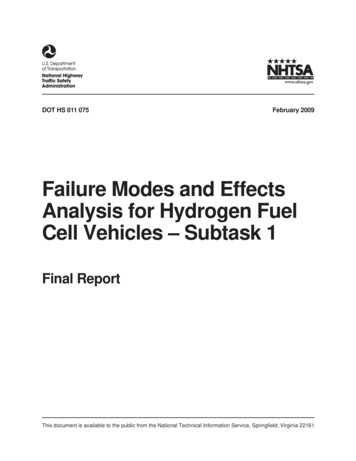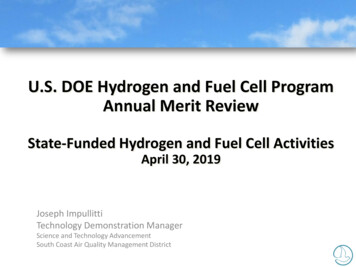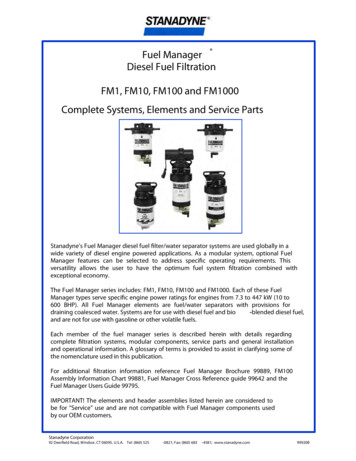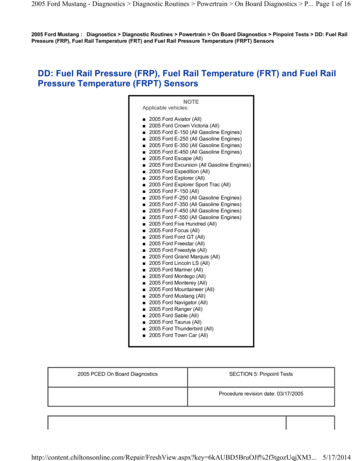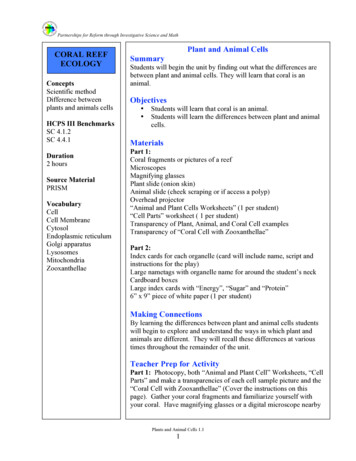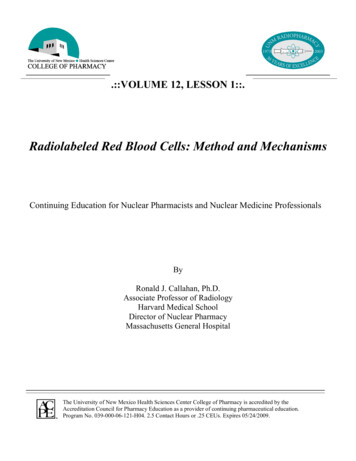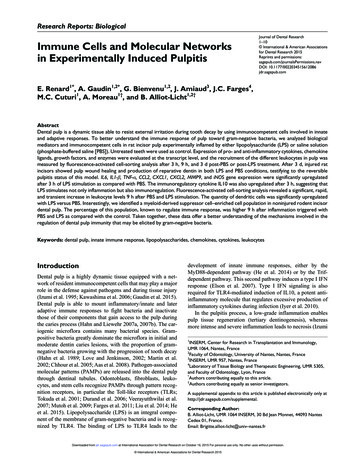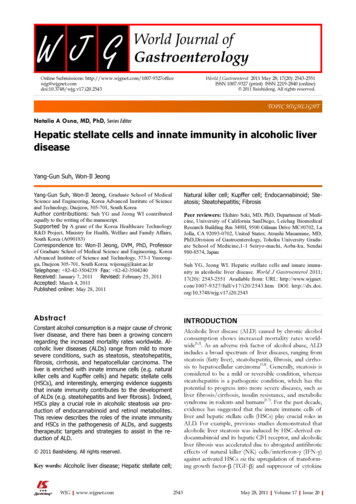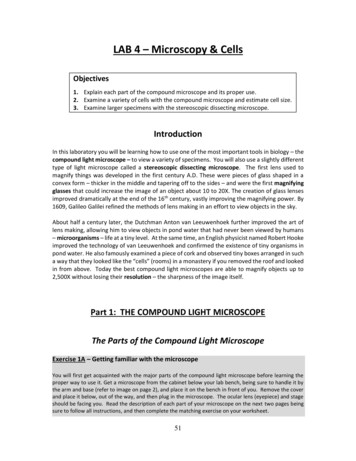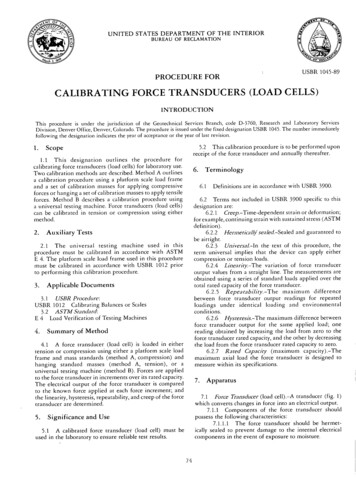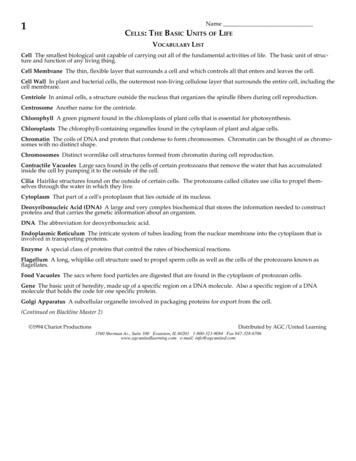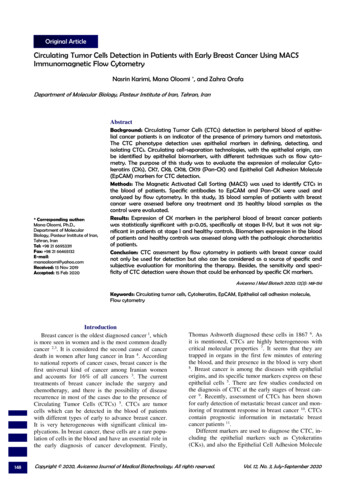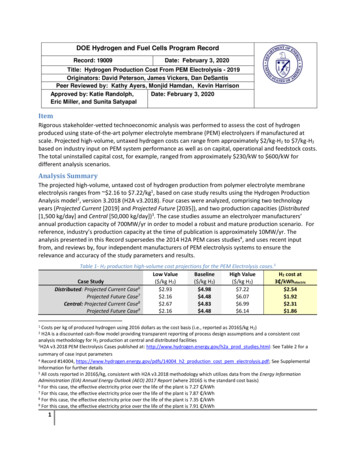
Transcription
DOE Hydrogen and Fuel Cells Program RecordRecord: 19009Date: February 3, 2020Title: Hydrogen Production Cost From PEM Electrolysis - 2019Originators: David Peterson, James Vickers, Dan DeSantis]Peer Reviewed by: Kathy Ayers, Monjid Hamdan, Kevin HarrisonA Date: February 3, 2020Approved by: Katie Randolph,aEric Miller, and Sunita SatyapalItemRigorous stakeholder-vetted technoeconomic analysis was performed to assess the cost of hydrogenproduced using state-of-the-art polymer electrolyte membrane (PEM) electrolyzers if manufactured atscale. Projected high-volume, untaxed hydrogen costs can range from approximately 2/kg-H2 to 7/kg-H2based on industry input on PEM system performance as well as on capital, operational and feedstock costs.The total uninstalled capital cost, for example, ranged from approximately 230/kW to 600/kW fordifferent analysis scenarios.Analysis SummaryThe projected high-volume, untaxed cost of hydrogen production from polymer electrolyte membraneelectrolysis ranges from 2.16 to 7.22/kg1, based on case study results using the Hydrogen ProductionAnalysis model2, version 3.2018 (H2A v3.2018). Four cases were analyzed, comprising two technologyyears (Projected Current [2019] and Projected Future [2035]), and two production capacities (Distributed[1,500 kg/day] and Central [50,000 kg/day])3. The case studies assume an electrolyzer manufacturers’annual production capacity of 700MW/yr in order to model a robust and mature production scenario. Forreference, industry’s production capacity at the time of publication is approximately 10MW/yr. Theanalysis presented in this Record supersedes the 2014 H2A PEM cases studies4, and uses recent inputfrom, and reviews by, four independent manufacturers of PEM electrolysis systems to ensure therelevance and accuracy of the study parameters and results.Table 1- H2 production high-volume cost projections for the PEM Electrolysis cases.5Low ValueBaselineHigh ValueH2 cost atCase Study( /kg H2)( /kg H2)( /kg H2)3 /kWhelectricDistributed: Projected Current Case6 2.93 4.98 7.22 2.54Projected Future Case7 2.16 4.48 6.07 1.92Central: Projected Current Case8 2.67 4.83 6.99 2.31Projected Future Case9 2.16 4.48 6.14 1.861Costs per kg of produced hydrogen using 2016 dollars as the cost basis (i.e., reported as 2016 /kg H2)H2A is a discounted cash-flow model providing transparent reporting of process design assumptions and a consistent costanalysis methodology for H2 production at central and distributed facilities3H2A v3.2018 PEM Electrolysis Cases published at: http://www.hydrogen.energy.gov/h2a prod studies.html: See Table 2 for asummary of case input parameters4 Record #14004, https://www.hydrogen.energy.gov/pdfs/14004 h2 production cost pem electrolysis.pdf; See SupplementalInformation for further details5 All costs reported in 2016 /kg, consistent with H2A v3.2018 methodology which utilizes data from the Energy InformationAdministration (EIA) Annual Energy Outlook (AEO) 2017 Report (where 2016 is the standard cost basis)6 For this case, the effective electricity price over the life of the plant is 7.27 /kWh7 For this case, the effective electricity price over the life of the plant is 7.87 /kWh8 For this case, the effective electricity price over the life of the plant is 7.35 /kWh9 For this case, the effective electricity price over the life of the plant is 7.91 /kWh21
Table 1 summarizes the cost projection results for hydrogen production (untaxed, delivery, & dispensingnot included) for the four cases. The baseline projections shown in the table capture representative systemcost and performance based on averages of the manufacturer-supplied input incorporated into thetechnoeconomic analysis. Electricity prices for these baseline projections were taken from EIA AEO Reportswith averages 0.07/kWh. The Low and High Values are included to reflect an expected cost spread (with90% certainty) as determined by Monte Carlo multi-variable analysis. Special assessment of the systemassuming a constant electricity price of 0.03/kWh, in line with the recent development of low costelectricity from renewable energy, is also shown in Table 1 and highlights the importance of electricityprice on electrolysis-based H2 production.Analytical BasisFour case studies centered on PEM-based electrolysis were performed using the H2A v3.2018 model.10 Thefour cases comprise two technology years: Projected Current (2019) and Projected Future (2035); and twoproduction capacities: Distributed (1,500 kg H2/day) and Central (50,000 kg H2/day). Technology year isdefined as the year in which a system design and electrolyzer cell/stack performance level have beendemonstrated in the laboratory with high confidence that it can be translated to and developed into a fullscale system able to achieve the stated performance, durability, and cost targets. Projected Current casesreflect demonstrated state-of-the-art 2019 technology but manufactured at high production volume. Thisdiffers from the existing commercial systems which are manufactured at significantly lower productionrates using slightly older technology. Projected Future cases use advanced electrolyzer systems that will betechnology-ready in 2035, with market entry assumed in 2040. Compared with the Projected Currentcases, the Projected Future cases incorporate expected reductions in capital cost, electricity usage, and sitepreparation cost as well as increases in the stack replacement interval.Relevant technoeconomic data and information for the cases were solicited from four independentelectrolyzer companies via questionnaire. Requested data included H2A input parameters needed fordeveloping the cases as well as supplemental information for the documentation and vetting of theunderlying technology assumptions. Data collected fell into five primary categories: (1) engineering systemdefinition; (2) capital costs; (3) operating costs; (4) variable and fixed expenses; and (5) replacement costs.The data and information were used as inputs for the four H2A case studies. For each case study, anengineering system performance model was developed from the baseline inputs to create a generalizedelectrolyzer system engineering design consistent with the diverse industry input from electrolyzermanufacturers. The engineering model was supplemented with a detailed ASPEN based model includingeconomic analysis. The generalized electrolyzer system schematic is shown in Figure 1.Based on the manufacturer inputs, literature review, and ASPEN design model, generalized system designswere developed for the Projected Current baseline cases that model electrolyzers operating at 2,000mA/cm2 with a H2 outlet pressure of 300 psi. The generalized system designs developed for the ProjectedFuture baseline cases were based on technologically-advanced electrolyzers operating at 3,000 mA/cm2with a H2 outlet pressure of 700 psi. Capital costs11 for each case assume a production rate of 700 MW/yr10H2A is a discounted cash-flow model providing transparent reporting of process design assumptions and a consistent costanalysis methodology for hydrogen production at central and distributed facilities. H2A addresses cost scenarios where sufficientlyhigh annual and cumulative volumes have been reached so that economies of scale for capital and unit costs have been achieved.Additional information can be found at: http://www.hydrogen.energy.gov/h2a production.html11All capital costs in this record are inclusive of markup2
and were developed through a combination of questionnaire responses, quoted equipment costs, andASPEN model economic adviser. The ASPEN Economic Adviser projects costs for single item purchases ofequipment. To align these equipment costs with manufacturing economies of scale of PEM operation(building enough production sites to handle a sum total of 700 MW/yr of input power), a cost reductionformula was applied to lower cost of equipment. For equipment in which 2-5 units are purchased inachieving the annual production rate, a 5% discount is applied to the single unit cost. For any equipment inwhich more than 5 units would be purchased to achieve the annual production rate, a cost reductionequation was used, lowering cost 10% for every 10x unit purchases. A high production rate is critical forachieving stack and balance of plant (BoP) cost reductions necessary for electrolyzers to achieve costcompetitiveness with other H2 generation technology. The four companies vetted the generalized inputsand designs for all H2A baseline cases, and participated in selection of reasonable parameter limits for H2Asensitivity analysis.Figure 1- Generalized PEM Electrolyzer System.12H2A v3.2018 specifies a standard outlet H2 pressure of 300 psi to allow cost comparisons across differentproduction technologies. Since the electrolyzer system Projected Future case outlet pressure is 700 psi, a“credit” is applied to the H2 cost to account for the higher outlet pressure compared to the nominal H2Avalue (300 psi). The credit is based on the power and capital cost of a notional compressor conducting12KO: Knock-out pot, generally used for separation of water from H2TSA: Temperature Swing AdsorptionThe rectifier-transformer equipment quote includes internal cooling equipment for heat rejection3
added compression. Compressor cost was calculated based on the compressor cost equations in HydrogenDelivery Scenario Analysis Model13 and compressor power was calculated based on flow rate, pressureratio (700 psi/300 psi), and efficiency (75%). The compressor credits amounted to 0.09/kg H2 and 0.05/kg H2 for the distributed and central cases, respectively. Using the generalized inputs and designsvetted by manufacturers, four baseline H2A v3.2018 case studies were performed (i.e., Projected CurrentDistributed, Projected Current Central, Projected Future Distributed, and Projected Future Central), toproject baseline hydrogen production costs. In addition, H2A sensitivity analysis was performed for eachcase, and illustrated in tornado charts, based on the vetted parameter limits.Baseline Input ParametersThe major parameters used to develop the four H2A v3.2018 baseline case studies are shown in Table 2 (allother H2A input parameters not cited in the table used standard H2A v3.2018 default values14).1314Hydrogen Delivery Scenario Analysis Model website: https://hdsam.es.anl.gov/index.php?content hdsamDefault values described at: http://www.hydrogen.energy.gov/h2a analysis.html#assumptions4
Table 2 - Input parameters for H2A Production cases for PEM electrolysis (costs in 2016 ).ParameterCurrentDistributed1,500 kg/dayFutureDistributed1,500 kg/dayCurrentCentral50,000 kg/dayFutureCentral50,000 kg/day20192035201920352015204020152040 599 379 460 233 342 143 342 143 257 236 118 91 136 140 36 23Electrical BoP Cost (2016 /kW) 121 97 82 68Total Electrical Usage (kWh/kg)[% LHV] (% HHV)55.8[59.7%] (70.6%)51.4[64.8%] (76.6%)55.5[60.1%] (71.0%)51.3[65.0%] (76.8%)Stack Electrical Usage (kWh/kg)[% LHV] (% HHV)50.4[66.1%] (78.2%)47.8[69.8%] (82.4%)50.4[66.1%] (78.2%)47.8[69.8%] (82.4%)BoP Electrical Usage (kWh/kg)5.43.665.043.54Stack Current Density (A/cm2)2.03.02.03.0Cell Voltage t Pressure from Electrolyzer (psi)300700300700Installation Cost(% of uninstalled capital cost)12%10%12%10%Stack Replacement Interval (years)710710Stack Replacement Cost Percentage(% of installed capital cost)1815%15%15%15%Plant Life (years)20204040Stack Degradation Rate (mV/khrs)1.511.51Cell Active Area (cm2)7007001,5001,500Capacity Factor (%)97%97%97%97%Technology YearStart-up YearTotal Uninstalled Capital (2016 /kW)15Stack Capital Cost (2016 /kW)BoP CapEx (2016 /kW)Mechanical BoP Cost (2016 /kW)16Electrolyzer Power Consumptionat Peak Production (MW)Effective Electricity Price over Life ofPlant17 (2016 /kWh)15All capital costs in this table assume manufacturing at volumes such that economies of scale have been achieved.16Mechanical BoP costs increase slightly between the Projected Current and future cases due to increased system operatingpressure. Costs between the Distributed and Central cases decrease substantially due an assumption of increased reliabilityleading to decreased number of Mechanical BoP modules and hence increased unit size with benefit from economies of scale.17 Effective electricity price over life of plant (20 years for Distributed cases and 40 years for Central cases)18 Stack Replacement Cost Percentage is estimated at 15% of the installed capital cost based on questionnaire responses. This costis meant to capture the net expense of stack replacement, inclusive of old stack residual value and installation cost.5
Baseline Cost Projection ResultsThe hydrogen production cost breakdown for the four H2A v3.2018 PEM electrolysis baseline cases isshown in Table 3. As shown in the table, the primary cost driver for H2 production is the electricity cost.The system electrical efficiency increases between the Projected Current and Projected Future cases (asseen in Table 3), while the average electricity price between the Projected Current case and ProjectedFuture case rises. As a result of these two changes between the cases, the overall electricity costcontribution to the price of H2 is slightly lower for the Projected Future than the Projected Current cases inTable 3. The cost contribution of electricity on the cost of H2 from Central production sites is slightlyhigher than the cost contribution of electricity in Distributed production sites due to the longer life of theCentral plants. The electricity price during the last 20 years of the Central plants is higher than theelectricity price of the life of the Distributed plants, which raises the overall effective electricity price of theplant over the course of its life. Overall, there is only a small cost reduction in moving from smallDistributed plants to large Central plants, and only a modest ( 10%) cost reduction between Pr
03.02.2020 · outlet pressure of 700 psi. Capital costs11 for each case assume a production rate of 700 MW/yr 10 H2A is a discounted cash-flow model providing transparent reporting of process design assumptions and a consistent cost analysis methodology for hydrogen production at central and distributed facilities. H2A addresses cost scenarios where sufficiently
